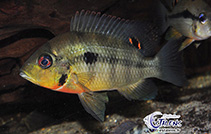| Family: |
Cichlidae (Cichlids), subfamily: Heterochromidinae |
| Max. size: |
29.5 cm TL (male/unsexed) |
| Environment: |
benthopelagic; freshwater, |
| Distribution: |
Africa: middle Congo River basin in Cameroon, Republic of Congo and Democratic Republic of the Congo (Ref. 52307). |
| Diagnosis: |
Dorsal spines (total): 14; Dorsal soft rays (total): 14-15; Anal spines: 3; Anal soft rays: 8-9. Description: fully grown specimens deep bodied (Ref. 52307). Body scales ctenoid (Ref. 44520). Upper profile of head elevated, concave in front of eyes, very high between them; greatest depth of head exceeding its length (Ref. 41594). Cheek scales cycloid (Ref. 44520), in 6-9 series with width of scaly part greater than eye diameter (Ref. 2989). Scales on rostral part of dorsum mixed cycloid and ctenoid (Ref. 44520). Mouth not extending to below anterior border of eye (Ref. 41594), but extending to between nostril and eye (Ref. 2989). Teeth conic, rather short, in rows with 7-8 teeth in middle and less on sides (Ref. 3062). Outer teeth better developed (Ref. 52343, 53262). Teeth caniniform in external row; pharyngeal teeth molariform (Ref. 3062). Pharyngeal apophysis formed by parasphenoid (Ref. 52330). Premaxillary processes moderate, not extending to between the orbits; snout rounded, longer than postocular part of head (Ref. 41594). Occipital crest very strong, extending forward in advance of interorbital region (Ref. 52330). Eye diameter much less than preorbital depth (Ref. 41594). Preoperculum and inferior part of head with large pores (Ref. 52343). Opercular scales large (Ref. 1884, 52343, 53262). Gill-rakers very short (Ref. 53262). Dorsal fin spines slightly increasing in length to the last, which is 2/5 of head length (Ref. 41594). Longest soft ray of dorsal fin about 1/2 of head length (Ref. 41594, Ref. 2989). Anal spines stronger than dorsal spines (Ref. 2989). Third (and last) spine of anal fin 1/3 of head length (Ref. 41594). Caudal fin slightly rounded to subtruncate (Ref. 52307). Scales on caudal peduncle strongly ctenoid (Ref. 44520). Pectoral fins not reaching vertical from origin of anal (Ref. 41594, Ref. 2989). Pelvic fins reaching vent (Ref. 41594, Ref. 2989).
Coloration: grey to brown and not spectacular (Ref. 52307). Dark brown band between eyes (Ref. 2989). Another on each side of body from head to caudal peduncle between lateral lines; a roundish blackish spot on lateral band above pectoral fin (Ref. 2989, 53262). Dorsal fin can have a thin red margin and a dark spot is often present at the base of the soft section (Ref. 52307). Juveniles: light brown with bronze reflections, and silvery with blue-green reflections ventrally; 5-6 dark transversal bands on body (Ref. 41580). 1 lateral band from posterior border of eye to base of caudal (Ref. 52307, 41580). Large black spot above pectoral fins, where lateral band crosses second transversal band; dark band on sides of back of head crosses eye and runs forward over cheeks and behind corners of mouth; dark bands are less clear in live specimens; dorsal and anal fin reddish and yellow; base of dorsal fin with a large black spot (as in Tilapia), followed by multiple series of black spots in oblique bands; anal fin slightly mottled with black; caudal fin and paired fins yellowish; pelvic fins more or less black in the largest specimens (Ref. 41580). |
| Biology: |
Old males can exhibit a remarkable head profile with a well-developed hump; probably a biparental substrate spawner (Ref. 52307). |
| IUCN Red List Status: |
Least Concern (LC); Date assessed: 16 February 2009 Ref. (130435)
|
| Threat to humans: |
harmless |
Source and more info: www.fishbase.org. For personal, classroom, and other internal use only. Not for publication.

